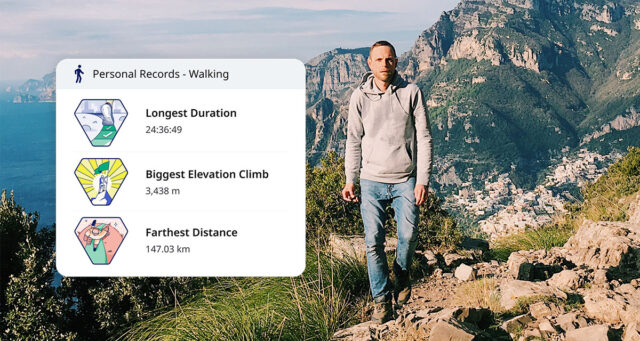While you’re probably aware that the ASICS Runkeeper app already tracks all the obvious running metrics like pace and elevation, there’s another one you might not be aware of: cadence, or the number of steps you take per minute. This feature allows you to understand your cadence, which in turn gives you a metric to monitor in order to improve your running form, decrease your risk of injury, and run faster.
You may be wondering: aren’t pace and distance all that I have to worry about with running? Why do steps per minute matter? So let’s first talk about what exactly cadence is and then discuss why it should matters to every runner.
What is running cadence?
Also known as stride rate, your cadence is the number of steps (counted on both feet) that you take per minute while running.
Runners with a high cadence will have a smooth gait, while runners with a low cadence seem to bounce up and down more. Most notably, runners with a low cadence are more likely to overstride and thus have a higher risk of injury.
The exercise physiologist Jack Daniels determined from statistical data at the 1984 Olympics that the ideal cadence for runners is 180 steps per minute. This doesn’t mean that every runner must have a 180 cadence; rather, 180 steps per minute represents the statistical average. You may take slightly more or slightly less steps per minute.
Daniels also concluded that runners change their stride rate very little (~3%) as they increase their speeds. Once you find a cadence that is comfortable for you, you will see little variance in your steps per minute from your easy run pace to your 5K pace.
Why cadence matters
With all of the metrics that you can track with running, why does cadence matter?
Increasing your cadence is one of the simplest ways to prevent common running-related injuries, including patellofemoral pain syndrome (runner’s knee). Increasing your cadence decreases the impact load on your lower body, according to study from the University of Wisconsin – Madison. A lower impact load means less risk of overuse injuries such as runner’s knee.
Read More: How to Deal with Runner’s Knee
A quicker cadence also minimizes your vertical oscillation (how high you bounce in the air while running), which in turn decreases your injury risk. As explained in Daniel’s Running Formula, a low cadence means you are spending more time in the air as you run and are elevating your body higher off the ground with each stride. What goes up must come down, and the higher you are off the ground while running, the more landing shock you endure when you hit the ground.
Your cadence and stride length correlate; runners with a low cadence are more likely to overstride. Overstriding occurs when your feet land in front of your body, which increases your landing shock. A study published in Medicine and Science in Sports and Exercise concluded that overstriding increases the risk of tibial stress fractures. By decreasing stride length, runners can reduce their risk of stress fractures by 3-6%.
So while cadence may not seem as important as pace or mileage, your stride rate has a direct impact on how often you are injured.
How to increase your cadence
Ideally, you do not want to increase your cadence by more 10% at once. According to the same study as cited above, increasing your cadence by more than 10% requires great oxygen consumption and therefore has a higher metabolic cost. Simply put, if you try to increase your cadence too much, you will burn more energy and thus have a higher rate of perceived exertion (RPE) at any given pace.
Steps to safely increase your cadence
- Determine your current cadence (that’s where Runkeeper comes in!) and multiply by 1.05. So if your current cadence is 165, you now want to strive for 173 steps per minute.
- During your runs, work on increasing your cadence to hit that number. You want to focus on landing your feet toward your center of gravity, rather than in front of you, taking short and quick steps, and landing lightly.
- Record your cadence over a series of runs and note where your average is. There should be little variance in your cadence (~3%) based on the type of workout.
- Once you have been running comfortably and injury-free at your new cadence for a few months, you can repeat the process if desired or needed.
Certain types of running workouts will also improve your stride rate naturally. You want to be careful when incorporating these workouts into your routine since they can increase your risk of injury if you run them with poor form. These workouts include:
- Strides: At the end of a run, run hard but not all-out for 100 meters (20-30 seconds), focusing on a quick turnover of your feet. Rest completely for 60-90 seconds. Begin with 4 strides and work up to 8-10 strides once or twice per week.
- Hill Repeats: After a warm-up jog of 10-15 minutes, find a hill with an incline of 4-8%. Run hard up the hill for 30-60 seconds, focusing on maintaining a quick stride rate and upright posture (don’t fold forward). Jog back down to recover and repeat for 4-10 reps, depending on your level of fitness.
As with anything in running, don’t make drastic changes quickly as that can be a recipe for injury. Gradually increase your cadence over time, and enjoy the rewards of faster, injury-free running!
Please note: This blog is not intended to be a substitute for professional medical advice, diagnosis, or treatment. Always seek the advice of your physician or other qualified health provider with any questions you may have regarding a medical condition.






